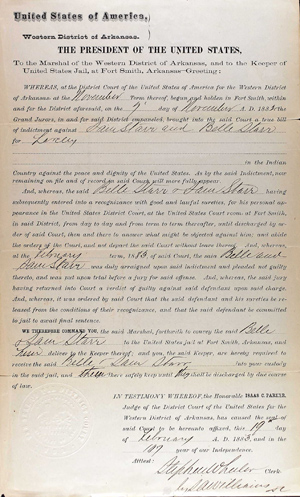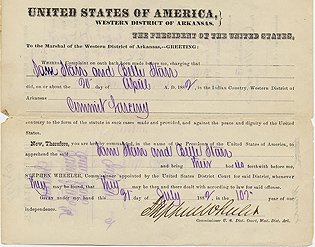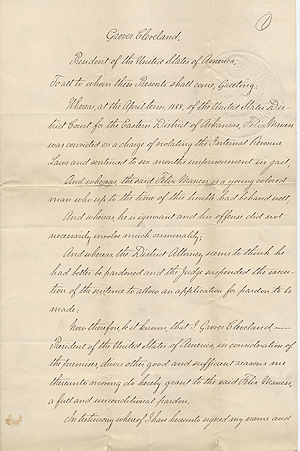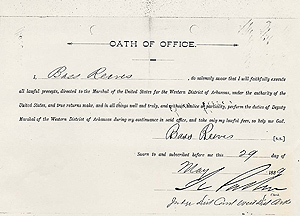
Research Guide to the Criminal Case Files of Fort Smith, Arkansas, 1860-1896
Introduction
If you know of an individual who lived in, walked through, or breathed near western Arkansas and the Indian Territory, you should look at the criminal case files for the U.S. District Court for the Western District of Arkansas, Fort Smith Division. This was the Wild West of murder and mayhem - especially involving liquor, “Hanging” Judge Isaac Parker, and lawmen like Deputy Marshal Bass Reeves.
Fort Smith's criminal case files are not typical court records. The court's original filing system was unique and makes the records difficult to search. Records were also moved or burned and intermingled with other court records. In 1863, fire destroyed files from the original court seat in Van Buren, Arkansas. In 1871, all court sessions were transferred to Fort Smith.
These records cover all types of cases from the large territory served by the court. The Federal court of the Western District of Arkansas was unusual because its jurisdiction extended outside the state and into Indian Territory, except for crimes committed among Indians. Most of the cases that came before the court involved criminal offenses, and the court’s decision was final. Until 1889, a defendant found guilty in the Western District Court could not appeal to any other court. Only the President of the United States could commute the sentence or pardon the defendant of the crime.
Where do I start?
Step 1
Start by searching the Fort Smith Criminal Case Files Index to see if the individual(s) came before the court. Search by full name (e.g. Belle Starr). There are two ways to access this index:
- Search the National Archives Catalog (NAC) for "Defendant Jacket Files for the U.S. District Court Western Division of Arkansas, Fort Smith Division, compiled 1866-1900"
or
- Go to Ancestry at www.ancestry.com and under the Search tab, select Card Catalog. Look for the title "Fort Smith, Arkansas, Criminal Case Files Index, 1866-1900." (The Index on Ancestry does not always sync with the National Archives' online catalog and may not be up to date.)
Please note: Ancestry.com is a subscription-based service, but is free when used from any computer at the National Archives.
Be sure to note the exact spelling of the individual's name, plus any additional details you will need such as the jacket number, crime, and any other name listed (alias or another person charged with your individual). This additional information can help you match the index entry with the case file and other records to tell a more detailed story of the crime and charges.
Step 2
Once you have located the individual’s name in the index, you will be able to search the criminal case files that have been digitized and made available on Ancestry. Under the Search tab, select the Card Catalog and look for the title "Fort Smith, Arkansas, Criminal Case Files, 1866-1900." Select "view original image" to be taken to the case file folder. Start browsing the folder's contents at the beginning of the file. If a manila folder image appears, this means you are at the beginning of the case file.
Be sure to note the jacket number assigned to the case file as this number may correspond to other Fort Smith databases included in this research guide.
If you are unable to find the case file for an individual on Ancestry, but the individual is included in the Fort Smith Criminal Case Files Index, please email us at kansascity.archives@nara.gov.
What can I expect to find in a Criminal Case File?
Criminal case files, which are also referred to as jackets, contain court documents that resulted from someone being charged with a violation of a criminal law. Criminal records generally do not contain biographical information, such as age, birth dates, addresses, or information about spouses, parents, or children. Records within each case vary as to content. If a defendant was not located by authorities, the file may contain only a few pages.
Fort Smith criminal case files include criminal writs against such famous outlaws such as Belle, Sam, Tom, and Henry Starr (jacket 170); Wyatt Earp (jacket 59); Grat and Emmitt Dalton (jacket 55); Rufus Buck (jacket 500); Edgar Watson (jacket 197); Blue Duck (jacket 26); and Crawford "Cherokee Bill" Goldsby (jacket 500). Some content may be unsuitable for younger audiences as it reflects the wide range of criminal charges associated with violence in the American Wild West.
Why do we call them jackets? Under Judge Isaac Parker, the writs and papers of Fort Smith District and Circuit Court criminal proceedings were filed alphabetically in numbered "pigeonholes" in a cabinet. When no space remained in the numbered pigeonholes, an additional system of lettered pigeonholes was started in a separate location. Later, the papers in each pigeonhole were transferred to the "jackets" that were, then, either numbered or lettered. Each jacket contains the folders or case files that span years for multiple defendants whose last names begin with the same letter of the alphabet.
Presidential Pardons and Commutations also are located in the individual's jacket. Until 1889, a defendant found guilty in the Western District Court could not appeal to any other court. Only the President of the United States could commute the sentence or pardon the defendant of the crime. Those with Presidential signatures are available in the National Archives Catalog. Type in the keyword "pardon" or "commutation" in search box to browse the images online. NOTE: Both "commutation" and "pardon" are forms of clemency, a presidential power. The difference is whether or not the conviction stands. A person who had his or her sentence commuted received a lesser punishment, often life in prison instead of the death penalty. A person who was pardoned received forgiveness of the crime and was no longer incarcerated. For records from 1889-1899, when criminals could appeal to the U.S. Supreme Court, go to Step 6.
Additional Resources:
Description of Federal Crimes- a list of the most common crimes and abbreviates used in court documents.
Court Records Glossary - a list of definitions of legal terms and types of documents found in the case files.
The Criminal Case Procedure in Judge Parker's Court - an outline of the steps that a criminal case would follow in Judge Parker's court via the Fort Smith National Historic Site.
For other types of court records that may contain relevant information, please see Step 3.
What If My Individual Was a Victim?
Many criminal case files do not include the victim by name. For those victims that are named in the case files, please use the Fort Smith Victim Index by clicking on the first letter of the Victim's surname.
A B C D E F G H I J K L M NO P Q R S T U V W Y Z
The index is arranged alphabetically by the victim’s last name and includes the name of the defendant, the charge, the year of the crime, and the jacket number. To find more information about the defendant, please see Step 1.
What If My Individual Wore a Badge?
The Federal Court for the Western District of Arkansas enforced U.S. law over the Indian Territory from 1851 until 1896. The Fort Smith National Historic Site has a database of deputy marshals and other federal court employees. Most of the men (and a few women) were sworn in as Deputy U.S. Marshals. Others served as sheriffs, jailers, court clerks, bailiffs, guards, posse, jail physicians, U.S. Commissioners, and U.S. Marshals.
The Federal Court for the Western District of Arkansas Court Employee Database, 1851-1896 is online. Search by the individual's first and last name to learn about his or her position, whether or not he or she was killed in the line of duty, and the oath of office date. (This database is an on-going project and is not inclusive.)
Oaths of Deputy Marshals, 1868-1971 are available in our catalog. Each oath contains the name and residence of the deputy marshal and the text of the oath. Not all deputy marshals who served have an oath.
Want More Information about a Criminal Case?
After finding information in a criminal case file, you want to know more. The criminal case files resulted from someone being charged with a violation of a criminal law. Records within each case vary as to content. If a defendant was not located, the file may contain only a few pages. Criminal records generally do not contain biographical information, such as age, birth dates, addresses, or information about spouses, parents, or children. However, there are other types of records to look at for more information.
Step 3
Index to Sentences, 1866-1890 references both the Sentence Record Books and the Common Law Record Books mentioned below. The index is arranged by the first letter of the last name and then chronologically by date. It contains the name of the defendant, criminal offense, conviction or acquittal date, and length of sentence. The index also includes numbers that refer to a volume and page number either in the sentence record books for the period of 1884-1890 or in the common law record books for the period of 1866-1884 mentioned below. Scanned pages of the volume can be viewed in the National Archives' online catalog.
Step 4
Sentence Record Books, 1884-1909. Each sentence record book contains information on persons sentenced by the court to confinement. In addition to the jail at Fort Smith, prisoners were sent to a variety of institutions, including state and county penitentiaries in Arkansas, Illinois, Michigan, New York, and Ohio, reform schools in the District of Columbia and Maryland, and the U.S. penitentiary at Leavenworth, Kansas. Each entry contains the name of the defendant, indictment number, criminal offense, place and length of confinement, amount of fine, and the sentencing date.
To learn if an individual is listed in the sentence books, see the list of names entered in the Fort Smith Sentence Books. The lists include the first and last name of each defendant, alias, indictment number, charge, date, and place of incarceration. Be sure to note the indictment number as this number will correspond to the criminal case in the common law record books below. This database was created by National Archives at Fort Worth volunteers and may not be complete. If an individual has a criminal case file but is not listed in the sentence books, he or she may have been found not guilty or the case never came before the court.
If the individual went to jail or a penitentiary, more records may be available at other locations. The National Archives at Kansas City has inmate case files for prisoners at the Leavenworth Federal Penitentiary (partial name index). The Burton Collection, Detroit Public Library has inmate registers and physicians reports from the Detroit penitentiary.
Step 5
Common Law Record Books, 1855-1959. These volumes are a record of the daily court proceedings, including orders issued in law, civil, and criminal proceedings heard in the Fort Smith court. They also contain orders admitting attorneys to practice before the court, appointing court officials, approving financial accounts of court officials, and naturalizations. There are no volumes for the period of 1861-1865 when the State of Arkansas was part of the Confederate States. A defendant could come before the court multiple times, and the case may be referenced on more than one page in the common law book. Unlike the sentence books, the common law books contain both defendants who were convicted AND those who were acquitted. For defendants convicted of the crime, the indictment number from their sentence corresponds to the number (No.) listed on the common law book.
Step 6
Transcripts of Testimony -- they only cover 1889-1899. Until 1889, cases heard in the Federal court of the Western District of Arkansas could not be appealed to any other court. Presidential pardons were the only recourse for those sentenced to death for capital crimes. After 1889, criminals could appeal to the U.S. Supreme Court. These records are arranged alphabetically and consist of transcripts of testimony given in the criminal proceedings. To see if a defendant has a transcript, see Transcripts of Testimony. This list includes the name of each defendant, charge, and date of transcript. NOTE: Presidential commutations of sentences are not included in the transcript; they are located within the individual's case file. To find out how to locate criminal case files, go to Step 1.
You may send your request for the case papers by mail to our address: National Archives at Kansas City, 400 W. Pershing Road, Kansas City, MO 64108 OR email us: kansascity.archives@nara.gov. Be sure to include the jacket information from the National Archives Catalog or Ancestry when requesting copies of the Fort Smith jackets.
Can't Find Your Individual?
Make sure the individual(s) you are researching was, indeed, in the western portion of Arkansas or Indian Territory during the middle to late 1800s. Then, try the various court records in Indian Territory. The National Archives at Kansas City has records pertaining to some Federal courts in Indian Territory, including Northern/Western District (Muskogee), Central District (South McAlester), and Southern District (Ardmore) but no records from other divisions in the Indian Territory or records from Oklahoma Territory courts (western portion of the State of Oklahoma and the Oklahoma Panhandle). The Oklahoma Historical Society has records relating to those individuals who were tried in tribal courts. The U.S. District Court, Paris, Texas, also had jurisdiction over southern portions of the Indian Territory, but the Paris federal court and all of its records were destroyed in a 1916 fire. Try newspapers, manuscripts, etc. in other repositories. Or perhaps your individual just did not get caught.
 Court order sending Belle and Sam Starr to jail.
Court order sending Belle and Sam Starr to jail. Arrest warrant for Sam and Belle Starr (jacket #170)
Arrest warrant for Sam and Belle Starr (jacket #170) President Grover Cleveland s Pardon of Felix Maness, 11/03/1888
President Grover Cleveland s Pardon of Felix Maness, 11/03/1888 Bass Reeves, Oath of Office, 1889
Bass Reeves, Oath of Office, 1889